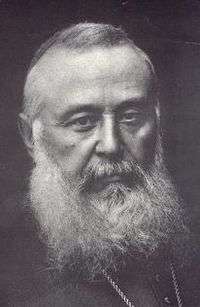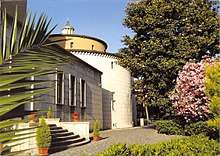White Fathers
| Pères Blancs | |
 | |
| Formation | 1868 |
|---|---|
| Founder | Cardinal Charles Lavigerie |
| Founded at | Algiers |
Membership | 1,769 (2009) |
The Missionaries of Africa, commonly known as the White Fathers or the Society of the Missionaries of Africa (French: Pères Blancs; post-nominals: M. Afr.) are a Roman Catholic society of apostolic life. Founded in 1868 by Archbishop of Algiers Cardinal Charles Lavigerie, the society focuses on evangelism and education, mostly in Africa. In 2009, the White Fathers numbered 1,769 perpetually vowed members and 354 students preparing to enter the society.
History

The cholera epidemic 1867 left a large number of Algerian orphans, and the education and Christian instruction of these children was the occasion of the founding of the society in Maison-Carrée (now El-Harrach) near Algiers; but from its inception the founder had in mind the conversion of the Arabs and the peoples of Central Africa. Missionary posts were established in Kabylie and in the Sahara. In 1876. In 1881 two caravans from South Algeria and R'dames, intending to open missions in Sudan, were massacred by their guides. In 1878 ten missionaries left Algiers to establish posts at Lakes Victoria, Nyassa and Tanganyika.
These now form the present Lakes Archdioceses of Kampala, Gitega, Tabora, and the dioceses of Kigoma, Lilongwe, and Kalemie-Kirungu. In 1894 the mission of French Sudan (now Mali) was founded, now the Archdiocese of Bamako.
The missions of the Sahara are grouped in a prefecture Apostolic. In 1880, at the request of the Holy See, the White Fathers established at Jerusalem a Greek-Melkite seminary for the formation of clergy of the Melkite Catholic Church. The society is composed of missionary priests and coadjutor brothers. The members are bound by an oath engaging them to labour for the conversion of Africa according to the constitutions of their society. The missionaries are not, strictly speaking, a religious institute, whether "order" or "congregation". Instead, they are a society of apostolic life. They may retain their own property; but they may expend it in the society only at the direction of the superiors.
One of the chief points in the rule is in regard to community life in the missions, each house being obliged to contain no fewer than three members. At the head of the society is a General-Superior, elected every six years by the chapter. He resides in Rome at the Generalate house on Via Aurelia. Those desiring to become priests or brothers are admitted to the novitiate after their philosophical studies. After the novitiate they spent two years of missionary training on the field and four years of theology. This training can be slightly different for brother candidates. The theological studies are spent in scholasticate presently located in Abidjan Ivory coast, Nairobi Kenya, Merrivale South Africa, Jerusalem. The society admits persons of all nationalities.
Dress and membership
The habit of the missionaries resembles the white robes of the Algerian Arabs and consists of a cassock or gandoura, and a mantle or burnous. A rosary and cross are worn around the neck in imitation of the mesbaha of the marabouts.
The society depends directly on the Congregation for the Evangelization of Peoples. The White Fathers succeeded in establishing small missions among the Kabyle Berbers, there being at present nine hundred and sixty-two Christians; but the regions bordering on the Great Lakes and Sudan show the best results. The number of neophytes in all the vicariates (as of June 1909) was 135,000; the number preparing for baptism 151,480. A test of four years is imposed on those desiring to be baptized. To religious instruction the missionaries add lessons in reading and writing, and teach also, in special classes, the tongue of the European nation governing the country, which was mostly French in these areas. The brothers train the young people for trades and agriculture. The number of boys in the schools (June, 1909) was 22,281.

In January 2006, the society numbered; 9 bishops, 1,498 priests, 156 brothers; 16 clerics with perpetual oath, and 5 associates. There were 354 students preparing to enter the society.
Leaders
Under the leadership of Archbishop (later Cardinal) Charles-Martial Allemand-Lavigerie, General Superiors were:[1]
| 1874 | 1880 | Fr. Francisque Deguerry |
| 1880 | 1885 | Fr. Jean-Baptiste-Frézal Charbonnier (later Bishop) |
| 1885? | 1886 | Fr. Léonce Bridoux (later Bishop) |
| 1886 | 1889 | Fr. Francisque Deguerry |
| 1889 | 1894 | Bishop Léon Livinhac (later Archbishop) |

Later Superiors General were:[1]
| 1894 | 1922.11.11 | Archbishop Léon Livinhac |
| 1922 | 1936 | Fr. Paul Voillard |
| 1936.04.22 | 1947.04.30 | Bishop Joseph-Marie Birraux |
| 1947.05.05 | 1957 | Bishop Louis-Marie-Joseph Durrieu |
| 1957 | 1967 | Fr. Léon Volker |
| 1967 | 1974 | Fr. Théoz Van Asten |
| 1974 | 1980 | Fr. Jean-Marie Vasseur |
| 1980 | 1986 | Fr. Robert Marie Gay (later Bishop) |
| 1986 | 1992 | Fr. Etienne Renaud |
| 1992 | 1998 | Fr. Gothard Rosner |
| 1998 | 2004.06.02 | Fr. François Richard |
| 2004.06.02 | 2010.05.31 | Fr. Gérard Chabanon |
| 2010.05.31 | Fr. Richard Baawobr (became Bishop of Wa - Ghana earlier in 2016) | |
| 2016.05.27 | Fr. Stanley Lubungo |
Zambia
The White Fathers also created mission stations in what was then Northern Rhodesia (now Zambia), particularly in the Luwingu District.
From a letter home written on 10th August 1930 by a 23-year-old fresh recruit to the Northern Rhodesian Government :- "My senior at Luwingu is a man called Wickins, whose wife is there with him, & they are the only white people on the station. The district is 6620 square miles in area, with 49,473 natives and only 12 whites all told; the other 10 are White Fathers - French missionaries with long white beards who never wash." [2]
And again, 13 September 1930 :- "On Thursday we went over to the Santa Maria mission on the island & had lunch there & saw round the place. They have just built a really wonderful Church - entirely by native labor & making their own bricks. There were 2 White Fathers - one French & the other German - but they were very keen to air their very indifferent English & wouldn't talk French!"
See also

References
- 1 2 "Missionaries of Africa M. Afr". GCatholic. Retrieved 2013-04-19.
- ↑ http://www.spanglefish.com/LettersFromGervas/index.asp?pageid=644934
![]()
External links
- Missionaries of Africa
- Missionaries of Africa in West Africa
- Missionaries of Africa UK
- Register to the Photograph Collection of the White Fathers (Society of Missionaries of Africa), National Anthropological Archives, Smithsonian Institution
